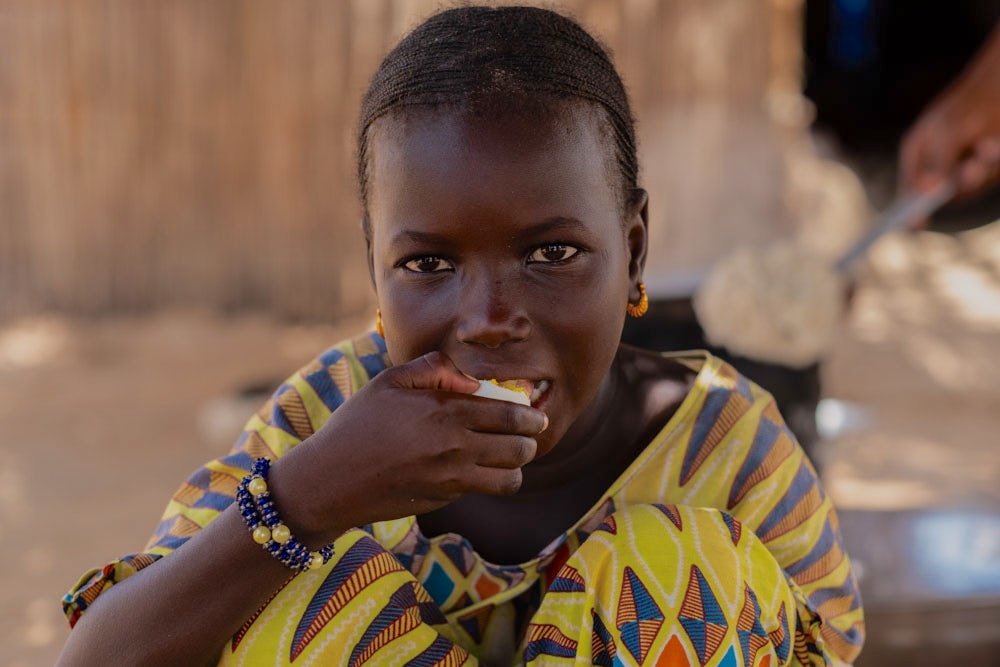Nearly two years into the COVID-19 pandemic, students around the world are confronting education that has taken on new forms: masks and plexiglass barriers, online learning, classrooms whose doors remain shuttered.

And while this health emergency is expected to have an enormous impact on worldwide learning — affecting billions of students — millions of learners are contending with another global crisis: hunger.
According to The State of Food Security and Nutrition in the World 2021 report, nearly 150 million children were stunted and 45 million were wasted in 2020, and the lingering effects of the pandemic are expected to cause an additional 62 million to be stunted or wasted by 2030.
In Heifer International’s project sites, especially, hunger is a hard truth. “The areas that Heifer works [in] are very poor communities,” said Neena Joshi, Heifer’s senior director of programs — cooperative development for Asia. “The nutritional status of the children is very bad. Stunting is rampant.”
This can have devastating — and sometimes permanent — consequences on a child: Hunger affects learning by curbing a child’s physical development, inhibiting their ability to focus and perform, and limiting their future achievements.
“The simple issue is the full potential that they have gets compromised because of the kind of food they eat,” Joshi said.
It starts with the brain.
Brain development begins soon after conception and determines a person’s functional ability, including social behavior, language development, decision-making skills, and learning and cognition. Research by Laurie C. Miller, a physician, professor and researcher; Mahendra Lohani, Heifer International’s senior vice president of Asia programs; Joshi and others has found children’s brain growth to be poor where malnutrition is prevalent.
Miller, Lohani and Joshi have conducted research together for two decades, partnering to understand the context in Heifer International’s project areas, as well as the impact of interventions designed to improve health and well-being. The results of their first study in Nepal drove the development of Heifer’s nutrition curriculum, which has since been adapted for each of Heifer’s country programs.

“When there’s an intentional dissection of the data gathering and analysis it gives a lot of feedback to the work we do,” Joshi said, indicating that research results help inform appropriate program design.
In one such study measuring head circumference — a simple determinant of brain size — undernutrition, including calorie deprivation and poor dietary diversity, contributed to diminished brain growth over the first four years of life for children in rural Nepal.
Brain development is one of the early effects of childhood undernutrition, Miller said, alongside other consequences like stunted growth and increased susceptibility to disease.
“Children are not only not getting adequate calories, but they’re not getting adequate micronutrients,” she stated. “And these are … really important to development. If you don’t have them in your diet when you’re a baby, you’re not curious [and] you’re not exploring. And if you aren’t curious and exploring, you’re not learning.”
Globally, undernutrition is widely linked to loss of development potential, with hunger and undernutrition causing low academic achievement, behavioral problems and limited economic opportunities. An estimated 250 million children under 5 in low- and middle-income countries are at risk of underdevelopment.
The effect of hunger on learning can be lifelong and cyclical, as malnutrition in childhood can manifest in lower productivity and fewer livelihood options in one’s adult years. The World Bank estimates today’s generation of students in low- and middle-income countries is at risk of losing about $10 trillion in future income due to low school enrollment and achievement.

“The long-term effects [of undernutrition] include problems with learning and school performance that can be quite significant,” Miller said, “and even short episodes of malnutrition or undernutrition can result in very long-lasting effects.”
Poverty is a significant driver of poor learning outcomes, with many families unable to purchase or access the food their children need to reach their full educational potential. Fewer earnings, as a result, can leave students who started in poverty trapped in it. And this cycle can endure for generations.
“When we work with communities, that’s very obvious,” Joshi said. “The children get sick and their schools are missed, and the hard work they put into their education is compromised. … There’s a whole cycle of how that impacts a community from not doing the best they can.”
Heifer’s work helping people build livelihoods that earn a living income is important to breaking the cycle of poverty in these fragile environments. Financial resources give families the freedom to prioritize education, pay for books and school fees, and provide the quantity and variety of food children need to grow and fulfill their potential — then foster the same in the next generation.

The physical and cognitive development that supports learning and productivity requires an army of nutrients and micronutrients — thiamin, zinc, riboflavin, iron, vitamin B6 — but the dietary diversity required to hit nutritional benchmarks can be difficult to achieve, especially in low- and middle-income countries where money and other resources are scarce.
“Most of the time in poor communities, food is filling stock, that’s all,” Joshi said. “If you are not hungry, then that’s good.”
Children’s diets are often cereal-based in these settings, incorporating few nutrient-dense foods like fruits, vegetables, milk or eggs. Half or more of all the calories consumed in developing countries come solely from grains, such as wheat and maize.
Improving access to a higher variety of foods is one of the most direct ways to help children avoid the permanent consequences of an insufficient diet and stop hunger from affecting learning and future outcomes.

Animal-sourced foods, including meat, milk and eggs, are especially linked to development potential. These foods are potent sources of energy and nutrients, high in protein, omega 3 fatty acids, iron, zinc, vitamin A, vitamin B12 and vitamin D, and diets deficient in them have been connected to poor cognitive ability in children.
Alternately, Miller, Lohani and Joshi have found more diverse diets, which include vegetables, fruits and animal-sourced foods, to correlate with better overall development in children, with one study in Far-Western Nepal finding dairy consumption alone made low total development 42% less likely.
These findings are consistent with those measuring head circumference and, therefore, brain growth. In this study, children under 3 who consumed two or more animal-sourced foods in the previous 24 hours had better head circumference scores than those who had eaten none or only one.
“It’s very important for the community to know the nutritional value of the food that’s available,” Joshi said, especially once they are earning more income and have more choices in what to purchase or plant.
In addition to supporting people to build profitable agricultural livelihoods, Heifer helps families raise more productive livestock and start kitchen gardens where they can grow a larger variety of fresh, nutritious food. The nutrition curriculum that was developed from Heifer’s first research project with Miller provides practical education about food groups, recommended diets based on locally available foods and the role of nutrients in physical growth. And Heifer’s values training tackles cultural norms that contribute to hunger and malnutrition, such as unequal food distribution among family members.
“As we start talking about the different food groups and how that helps you keep healthy, and how [it] impacts the health of the children and, ultimately, their performance in their lives, that’s an ‘aha’ moment for a lot of people,” Joshi said.